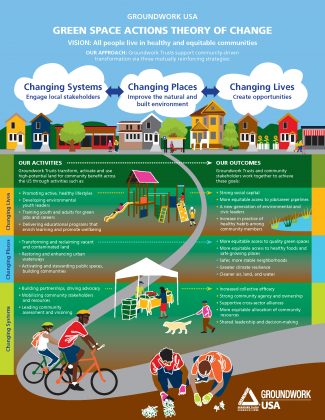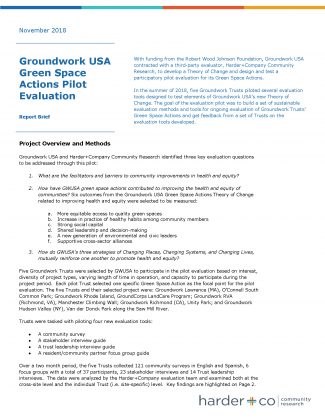Can the act of collaboratively transforming brownfields and vacant, abandoned, and/or underutilized properties into high quality green spaces—like parks, greenways, trails, and gardens—benefit the health of longtime community residents and prevent their displacement?
From June 2017 through December 2018, Groundwork USA has sought to answer this and other pressing questions through our Green Space Actions Evaluation Project. The recently completed evaluation was designed to gather preliminary evidence of positive and equitable community health impacts brought about by Groundwork’s model of collaborative, community-led revitalization of neglected spaces—what we call our “green space action” work. At the same time, we sought to clarify the guiding principles of this work to advance health equity.
Why Evaluate Our Green Space Actions?
“How have Groundwork green space actions contributed to improving community health and equity?”
Over the years, many of us who’ve been involved in our green space action projects noticed something happening in Groundwork communities as a result of the work—something beyond the very visible “changing places” and “changing lives” that our tagline asserts. Although the changes we saw happening were invisible to some, we felt certain they were tangible to the people intimately involved in green space actions through building relationships and connections, sharing leadership of a broad agenda, and doing the work together, in community.
What’s more, we knew that the tracking system we used to measure the impact of our work in communities needed some upgrades in order to document more fully what was happening on the ground. While our performance measures have long captured the “outputs” of our place-based work—that is, tallying the number of trees planted, acres of brownfields reclaimed, youth engaged, and so on—we recognized that the stories we regularly hear from Groundwork communities, the first-hand accounts and anecdotes, offer the best way we could think of to give voice to what was—and is—happening in Groundwork communities.
The Green Space Actions Evaluation Project
Our hypothesis:
The act of collaboratively transforming brownfields—vacant, abandoned, and contaminated properties—into high-quality green spaces provides an opportunity for a community to practice cross-sector leadership while investing in local stakeholders to strengthen a community’s sense of ownership, promote community healing, build wealth and wellness, and understand how this work contributes to the social determinants of health.
With this hypothesis in mind, Groundwork USA secured funding from the Robert Wood Johnson Foundation to design and pilot an evaluation methodology centered on the impact of our green space actions on community health.

Specifically, we sought to:
- Develop and codify a theory of change and evaluation methodology tied to our green space action work,
- Evaluate whether that work is producing a notable impact on the social determinants of health in the surrounding communities, thereby affecting broader community health outcomes in a positive way, and
- Add depth to that body of evidence, bringing it to life through first-hand stories of green space action experiences and observations.
Groundwork USA contracted with a third-party evaluator, Harder+Company Community Research, to help us develop a Green Space Actions Theory of Change—our organization’s first formalized, detailed description of how the strategies and activities that make up our green space actions contribute to a chain of results that produce observable outcomes. Harder+ Company also designed and tested a participatory methodology to measure how green space actions may be moving people in Groundwork communities toward whole health and wellness.
In the summer of 2018, five Groundwork Trusts (in Richmond, Virginia; Richmond, California; Rhode Island; Yonkers, New York; and Lawrence, Massachusetts) piloted several evaluation tools designed to test elements of Groundwork USA’s new Theory of Change. The goal of the evaluation was to build a set of participatory methods and tools for ongoing evaluation of Groundwork Trusts’ community-driven green space actions and get feedback from the participating Trusts on the evaluation tools developed.
 Alongside collecting baseline data for tracking health equity outcomes over time, we also gathered the stories of people actively participating in green space actions in the evaluation communities. Their voices lend an important first-hand perspective on the impacts of our work together.
Alongside collecting baseline data for tracking health equity outcomes over time, we also gathered the stories of people actively participating in green space actions in the evaluation communities. Their voices lend an important first-hand perspective on the impacts of our work together.
Findings and Discussion
A central question we asked in our pilot evaluation was “How have Groundwork green space actions contributed to improving community health and equity?” Groundwork USA’s evaluation answers this question by demonstrating preliminary evidence that Groundwork Trusts are indeed creating near-term community health impacts, including the following:
Groundwork green space actions are assuring more equitable access to green spaces.
From a survey of 121 community members from Groundwork communities participating in the evaluation, we learned that the average walk time from home to a Groundwork green space action was 12.8 minutes among community members surveyed. We see this data as an important and validating benchmark for our green space actions work, as widely accepted research shows that living within a 10-minute walking distance of a quality park or green space is good practice. Research also asserts what low-income communities and communities of color have long known first-hand: that access to green space is inequitably distributed across urban populations. These are issues that Groundwork Trusts and our green space actions actively seek to address.
Groundwork green space actions are strengthening social capital.
Of the 121 residents of Groundwork communities surveyed in the evaluation, 75% of respondents agree or strongly agree that the Groundwork green space action in their community helps them see more members of their community interacting with each other. This finding is important because research shows that the greater the degree of residents’ civic engagement, the stronger they perceive their bonds with their community. In turn, residents who report higher levels of bonding social capital also reported higher levels of neighborhood collective efficacy. In short, this finding tells us that the work a community does to drive a Groundwork green space action to completion creates important “collaborative infrastructure” from which communities can develop common purpose and drive a shared equity agenda.
Perceptions of the interpersonal trust, sharing, and reciprocity within and between social networks. Civic engagement is a shared value among stakeholders in the community.
Collective efficacy
Community members are able to come together for the good of the community to achieve common goals and preserve shared values.
Groundwork green space actions are creating a new generation of environmental and civic leaders.
Feedback from focus groups held with Trust youth and job training program participants supported the claims of Groundwork leaders and community stakeholders about the value of participation in Groundwork green space actions. Specifically, Trust leaders and stakeholders talked about:
- Connecting youth to employment opportunities in environmental sector, inspiring them to find environmental job opportunities;
- Teaching youth about green spaces, awareness, understanding, and appreciation for nature;
- Building leadership by educating youth about the history of their communities
These sentiments also came through in the comments of youth focus group participants when asked about their growth as leaders and about what or who helped in their career growth and development.
Groundwork USA is excited about these findings, as they offer our first bundle of evidence that green space actions are indeed creating near-term community health impacts. A challenge we face is that evidence of health equity outcomes takes a long time to see across populations. Since our evaluation timeline lasted just two months, we sought to understand the ways in which Groundwork’s approach creates the antecedents of health equity in the near-term. Given this, we analyzed the evaluation findings with an eye toward identifying those aspects of our green space action work that set the stage for improved health and equity outcomes to unfold among members of a community over time.
In examining these and other indicators of impact, we feel confident that the early findings of our evaluation offer promise that evidence of more health equity outcomes will emerge in Groundwork communities where green space actions have taken place over a longer period of time—perhaps one or two decades. It’s still too early to tell, and we still have much work to do to continue changing places and lives, and ultimately, changing systems to produce more equitable health outcomes for communities.
Our team is excited to work with Groundwork Trust affiliates to integrate the evaluation methodology into their current and future green space action work. Building the capacity of Groundwork practitioners and community stakeholders to utilize the evaluation tools and methodology piloted for this pilot project and continuing to gather data will enable Groundwork USA to better track our national network’s outcomes over time.
What we can see very clearly from the stories we’ve gathered and share here—and from scores of stories not yet told—is that something special is happening across Groundwork communities through our green space action work. We have much more to learn, and we will continue studying these findings as we continue gathering and analyzing our data and our work over time.
What we now know to be true—and backed by preliminary evidence—is that the act of reclaiming underutilized land by and for community members represents an important opportunity for a community to develop and drive an “all hands on deck” equitable development strategy. When green space actions are co-designed and co-led by teams of residents and young people as chief architects and voices, opportunities emerge to holistically address the social determinants of health in the surrounding community, thereby investing in people alongside place.
Our vision is that these types of silo-busting green space actions can be replicated in communities across the country and, over time, build the kinds of collaborative infrastructure from which community stakeholders can begin to take on long-intractable challenges—like disrupting the repeating patterns of green gentrification and displacement—as they design, lead, and leverage their green space actions for a more equitable future, together.
Acknowledgments
The Groundwork USA team offers special thanks to the Healthy Communities Advisory Board members, who offered their perspective, guidance, and support throughout the course of this project.
- Mariana Arcaya, Assistant Professor for Urban Planning & Public Health, Massachusetts Institute of Technology
- Vedette Gavin, Director of Research and Partnerships, Conservation Law Foundation
- Peter James, Assistant Professor, Department of Population Medicine, Harvard Medical School
- Viniece Jennings, Research Scientist, USFS Southern Research Station
- Joseph Schilling, Senior Research Associate, Urban Institute
